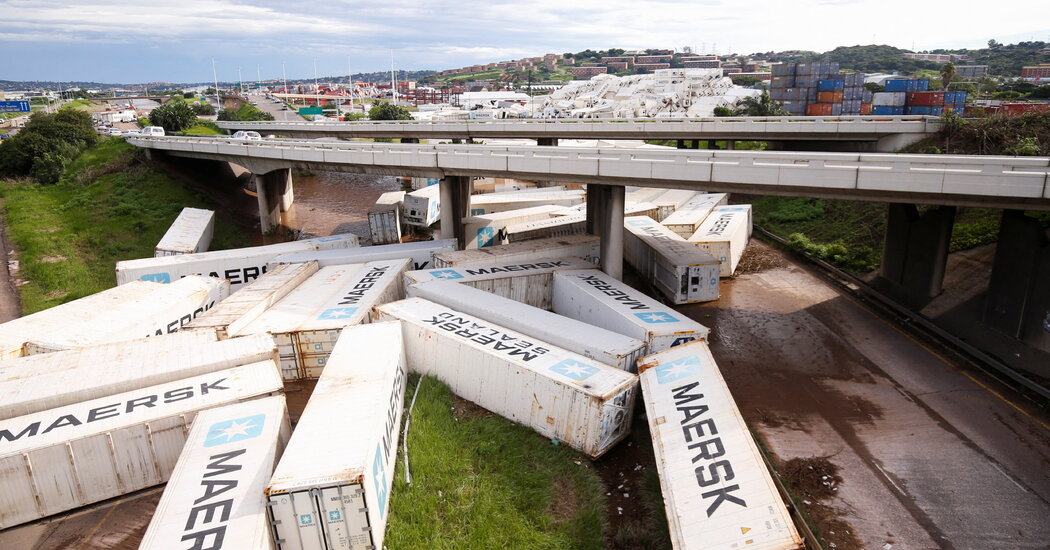Heavy Floods and Mudslides Leave at Least 45 Dead in South Africa
JOHANNESBURG — Days of heavy rain on the eastern coast of South Africa left at least 45 people dead when rivers burst their banks and mudslides swept through the city of Durban and the surrounding area.
The death toll is expected to rise as members of the South African National Defense Force were called in to assist emergency rescue teams in the KwaZulu-Natal province, government officials said Tuesday. Along the coast, vacation homes and shacks alike were swept away in a part of the country known as a getaway for its sun, beaches and warm temperatures.
“We were all surprised by the magnitude of this storm,” Mxolisi Kaunda, the mayor of Durban, said in a news briefing.
Storms have already caused devastation in several countries in the Southern African region this year, displacing thousands of people and leaving dozens dead. Some scientists attributed the destruction in part to a storm season intensified by rising global temperatures.
The island nation of Madagascar has been worst affected, hit by a cyclone and four tropical storms that left at least 178 people dead during February and March.
But the storms, originating in the southern Indian Ocean, pummeled the mainland as well. Thousands were displaced along Mozambique’s coastline, with flooding reaching as far inland as landlocked Malawi and Zimbabwe. South Africa’s eastern KwaZulu-Natal province also saw heavy rain and flooding in February.
On Tuesday, a new storm left much of the city of Durban flooded. Footage from emergency services showed parts of a national highway resembling a river, with shipping containers dislodged and washed away. In Verulam, a township north of the city, two people were killed when a house collapsed overnight, according to a local emergency services team.
Residents sought refuge on higher ground, climbing onto the roofs of houses, office buildings and a Hindu temple, according to rescue workers.
In Tongaat, a town 40 minutes north of the city center, a woman driving home with children in the car on Monday evening was swept away when a stream swelled to a gushing river that broke its banks, said Bilall Jeewa of Gift of the Givers, a charity group. The bodies of the woman and two children were found, but the body of a third child presumed dead had yet to be recovered.
The floods also brought landslides that destroyed roads and homes in the region. The lower floors of seaside holiday apartments along the north coast were buried by reddish-brown mud, while hillside homes hung precariously after their foundations were washed away, according to video shown on national television.
Shanty towns built along rivers were among the most vulnerable, and shack homes were washed away by floodwaters or covered by mud and debris.
In a shantytown in Clare Estate, a suburb north of the city, residents dug through mud, metal and wood to try to rescue a family of five trapped in their shack — but the rescuers were too late, said Robert McKenzie, a spokesman for the KwaZulu-Natal Emergency Medical Services.
Even as the water receded, emergency workers were struggling to reach the affected areas. By the afternoon, dozens of schoolchildren and their teachers remained trapped in their classrooms, waiting to be rescued, Kwazi Mshengu, head of the provincial education department, told eNCA, a national news broadcaster. Nearly 100 schools had been damaged, and 500 schools in the region were closed, he said.
Large parts of the city were without electricity and water after power stations and water treatment plants were damaged, said Mr. Kaunda, the Durban mayor. The city is still recovering from widespread riots and looting last July, during some of the worst civil unrest to roil South Africa since the end of apartheid.
Rain was expected to continue pounding the area on Tuesday and again later in the week, according to the South African Weather Service.
The heavy rains stem from a common weather phenomenon in South Africa known as a cut-off low, in which a low pressure system develops and its flow across the atmosphere is disrupted, resulting in a slow-moving storm.
“It is very common for this time of year,” said Kgolofelo Mahlangu, a forecaster with the weather service, noting that similar heavy rains battered the region around this time in 2017 and 2019.
Some climate scientists are attributing the increase in the intensity of the recent storms to environmental changes. A study published this week by World Weather Attribution, an initiative that specializes in pinpointing the links between climate change and individual weather events, said that “climate change is elevating risk in places where tropical cyclones are already affecting agriculture, infrastructure, livelihoods and lives.”
The study looked at rainfall levels during Cyclone Batsirai and Tropical Storm Ana in January and February. The research, while noting gaps in data from the region, found that human-caused global warming had played a role in making those storms more intense.
John Eligon contributed reporting from Ulundi, South Africa, and Raymond Zhong from New York.
Check out our Latest News and Follow us at Facebook
Original Source






